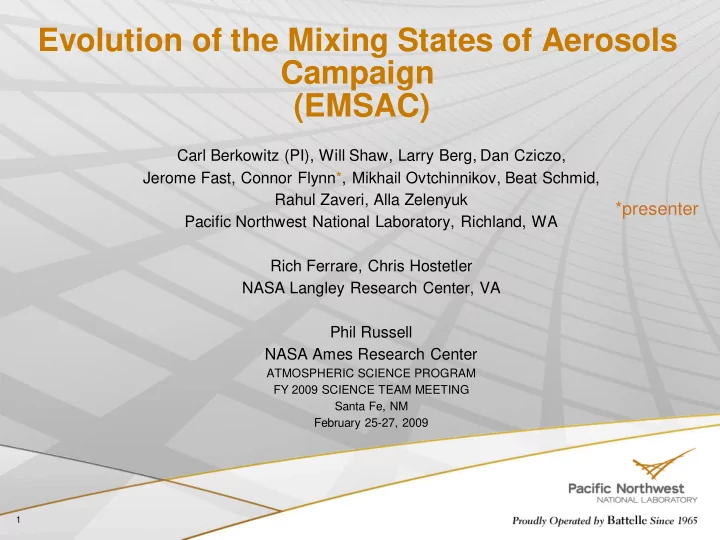

Evolution of the Mixing States of Aerosols Campaign (EMSAC) Carl Berkowitz (PI), Will Shaw, Larry Berg, Dan Cziczo, Jerome Fast, Connor Flynn*, Mikhail Ovtchinnikov, Beat Schmid, Rahul Zaveri, Alla Zelenyuk *presenter Pacific Northwest National Laboratory, Richland, WA Rich Ferrare, Chris Hostetler NASA Langley Research Center, VA Phil Russell NASA Ames Research Center ATMOSPHERIC SCIENCE PROGRAM FY 2009 SCIENCE TEAM MEETING Santa Fe, NM February 25-27, 2009 1
How valid are the mixing assumptions in models? Are particles externally mixed (e.g. global models) or internally mixed (e.g., detailed process models). When? Where? The mixing state of particles affects their optical and activation properties through Complex refractive index = f(composition) Critical supersaturation = f(composition) There is a large element of uncertainty in the Kohler curves showing range in SS for various compositions. descriptions of the mixing state of particles From Kelly, Chuang, and Wexler. 2006. "Influence of dust composition on cloud droplet formation." Atmospheric Paucity of observations Environment 41(14): 2904-2916, doi:10.1016/j.atmosenv.2006.12.008 Complexity of added emissions 2
Proposed Campaign Overview: “…summertime field campaign in 2011 to investigate the evolution of the mixing state of aerosols and the consequences of this evolution on the direct and indirect effects of aerosols off the east coast of the continental U.S.” Goal: “to provide key measurements of aerosol composition, size and The COVE site (from http://cove.larc.nasa.gov). Aircraft optical properties (both local and would sample east from Langley, VA. columnar) needed to evaluate existing models and to aid in the development of new models suited to study both direct and indirect effects of aerosols on climate.” 3
Why East Coast? Key Advantage: relatively simple emissions encountered once a parcel of air moves away from land and over the ocean. Much useful information about mixing state of particles emanating from Mexico City: much of this work had to take into account the addition of emissions encountered by these particles as they were transported to the downwind measuring sites emissions along transport pathways complicated analysis of the composition and other physical properties of the particles being studied. Many past campaigns on east coast (e.g., NEAQS, TARFOX) We know something about this area but We propose to carry out model evaluations on particle mixing states and radiative state of atmosphere 4
What’s New? Unique measurements to address mixing state/radiative properties including: observations of optical depth (including slab-AOD) with in situ aerosol characterization to measure mixing states, all from a single platform profile and columnar observations of key aerosol properties and an extensive set of surface based measurements at the CERES site. Also measurements focused over a more limited geographical area so as to develop a set of key measurements within a common region. Would contrast observations within marine boundary layer/CERES and aloft/aircraft. 5
Key Platforms G-1 aircraft: instrumentation to provide aerosol mixing state (SPLAT II) – Alla Zelenyuk column and layer measurements of aerosol properties of optical depth, single scattering albedo, and size distribution (4STAR) – Beat Schmid and Connor Flynn CCN spectrum, 3- λ scattering, absorption, aerosol and droplet size spectra. NASA aircraft: instrumentation to provide ( Chris Hostetler and Rich Ferrare) aerosol backscatter, extinction (High Spectral Resolution LIDAR) aerosol effective radius, surface and volume concentrations, refractive index, single scattering albedo (the Research Scanning Polarimeter ). The CERES Ocean Validation Experiment (COVE) site at Chesapeake Lighthouse, located in the Atlantic Ocean, 25 km east of Virginia Beach. 6
For more information: see ASP Webpage: http://www.asp.bnl.gov/prospective_field_projects “EMSAC_ConceptPaperBerkowitz.pdf” Contact: Carl.Berkowitz@pnl.gov, (509) 372-6183 Will.Shaw@pnl.gov , (509) 372-6140 Chris.A.Hostetler@nasa.gov, (757) 864-5373) 7
Recommend
More recommend